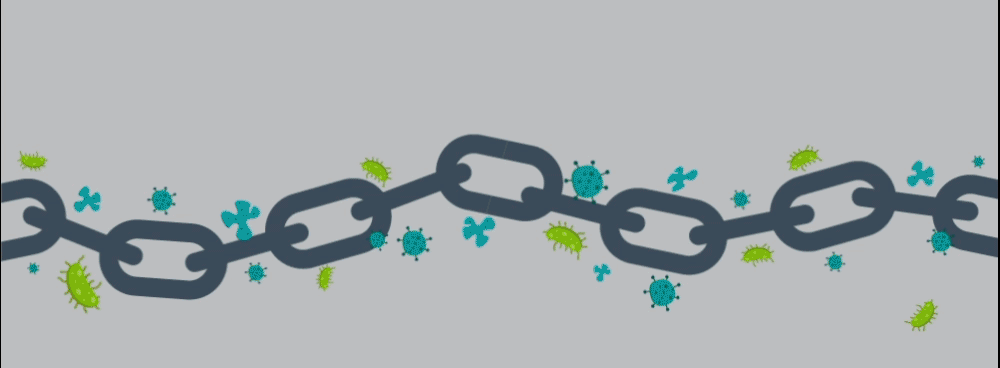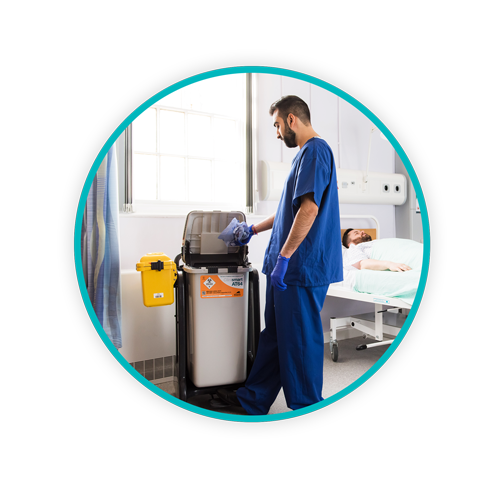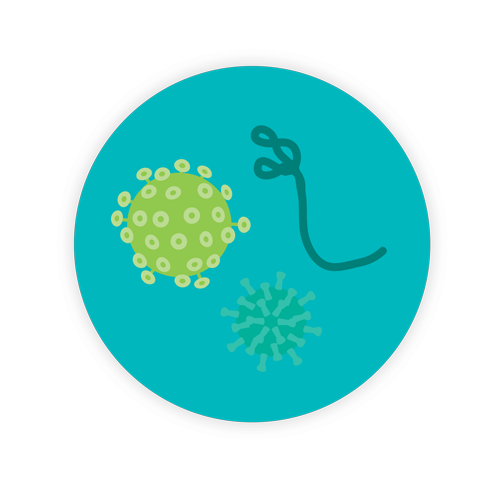How Reusable Containers Break the Chain of Infection

When it comes to reusable items and products for the healthcare environment, infection prevention and control principles have to be factored into the design very early in the process. This is especially true with something as crucial as a reusable sharps bin. Let’s see how reusable sharps containers break the chain of infection and the peer-reviewed research that demonstrates why transmission isn’t possible.
TOPICS WE WILL COVER:
1 / The importance of infection prevention and control in healthcare.
2 / What is the chain of infection?
3 / How reusable containers break the chain of infection.
4 / More on the C. diff transmission potential of sharps containers.
5 / A sustainable solution that doesn’t compromise infection prevention and control.
The Importance of Infection Prevention and Control
Infection prevention and control defines the measures that are used to prevent the spread of avoidable infections among patients, staff, and visitors. Such measures have proven time and again to reduce the likelihood and incidence of healthcare-associated infections (HAIs). HAIs can have severe consequences on patients and can also result in increased costs on the healthcare system and the closure of hospital wards or units – bringing about further negative impacts on patient care.
Everyone working in the healthcare environment has a part to play and a practical way to ensure adherence to infection control measures is to understand what the chain of infection is and how it works.
What is the Chain of Infection?
The chain of infection is a six-link representation of the series of events in which infection passes from one person to another:
Infectious Agent – The pathogen that causes diseases.
Reservoir – Place in the environment where the pathogen lives.
Portal of Exit – The way the infectious agent leaves the reservoir.
Mode of Transmission – The way the infectious agent can be passed on.
Portal of Entry – The way the infectious agent can enter a new host.
Susceptible Host – Any person that may receive the infection.
When a single link is interrupted, it breaks the chain of infection and transmission isn’t possible.
A Note on Germs
As a healthcare worker, you’re likely to be familiar with Clostridium difficile (C. diff) – a germ (bacterium) that can infect the bowel and cause diarrhoea and colitis, usually affecting people that have been taking antibiotics. But what about spores? When C. diff germs are outside the body they become spores – a germ that has fallen asleep (inactive) in a suit of armour (protective coating) and can potentially live for a long time.
How Reusable Containers Break the Chain of Infection
Reusable containers should always be designed to minimise infection risk and as mentioned above, each of the six links in the chain of infection are essential for disease transmission to occur – If just one of those links is broken, transmission isn’t possible. To demonstrate how reusable containers break the chain of infection, we’ll be referring to an academic study published in the American Journal of Infection Control that tested the pathogen transmission potential of reusable sharps containers. Let’s begin with one of the most likely places to see the spread of infection in a healthcare environment.
The Patient Environment
The patient environment may serve as a reservoir for the transmission of C. diff spores to susceptible patients – the surfaces most commonly associated with Clostridium difficile infection (CDI) transmission are high-touch, contaminated surfaces close to patients.
Confirming that a “pathogen”, “portal of entry”, “susceptible host”, and “portal of exit” are present, leaves “reservoir” and “mode of transmission” to investigate to determine the possibility of reusable sharps containers being associated with infection transmission.
Reusable Containers as a Reservoir for Infection
Not all surfaces have the capability to act as a reservoir for C. diff and to classify a sharps container as a reservoir, it needs to be contaminated with a high enough density of the pathogen in question to amount to an infective dose. Except for bathrooms, surfaces further from the patient’s bed are contaminated less often and less heavily than frequently touched surfaces close to the patient such as bed rails, bedside tables, call buttons, etc. When it comes to airborne spores, they tend to group together and fall to the floor relatively quickly, but even if they did land on low-touch surfaces it shouldn’t matter since they’re infrequently touched.
The epidemiology shows that wall-mounted sharps containers kept at a distance from the patient and not touched during use would have little spore bioburden. The spore density in the patient environment was found to be extremely low on reusable containers (no higher than on disposables), and some 1000 times higher on other surfaces in the patient environment. So, containers would need to arrive on-site already covered in enough spores to infect someone to be in any way related to CDI, but a thorough washing process removes the spores and therefore proves this to be implausible.
So, can reusable sharps containers be a reservoir for infection?
With an insufficient number of spores found on the containers to constitute an infective dose, they meet neither the epidemiologic nor the microbiologic criteria for “reservoir”. This breaks one link in the chain of infection, and transmission isn’t possible.
Reusable Containers as a Mode of Transmission for Infection
For a reusable sharps container to act as a mode of transmission, the spores need to get from the container to the patient.
But how? There’s no bus route after all…
The most common mode of transmission of C. difficile to patients is via the hands of healthcare staff who have touched heavily contaminated surfaces close to the patient and then touched the patient. Hands-free disposal is one of the key safety features of reusable sharps containers, allowing the user to drop a sharp into the aperture without the need to touch the container with either the depositing hand or the free hand. It’s also worth noting that clinical staff must wear gloves while attending CDI patients. It’s best practice to remove gloves and follow hand hygiene after each patient interaction – it’s mandatory when there’s potential exposure to blood and body fluids.
So, can reusable sharps containers be a mode of transmission for infection?
In either scenario (touchless sharps disposal and/or removal of gloves), a “mode of transmission” to a patient isn’t possible. This breaks a second link in the chain of infection, and transmission isn’t possible.
More on the C. Diff Transmission Potential of Sharps Containers
Brace yourself for some big words and impressive numbers…
A multi-centre “Microbiological study to investigate the carriage and transmission potential of Clostridium difficile spores on single-use and reusable sharps containers” explored and challenged the idea that sharps containers could play a role in CDI transmission. The researchers used a multi-faceted epidemiologic, microbiologic, chain-of-infection, and test-of-evidence approach to conduct their investigation.
The results proved the safety of reusable sharps containers and demonstrated no foundation for the assertion that they may be a fomite (an inanimate object that can carry and spread disease and infectious agents). Before the patient environment investigation, the researchers took samples of 197 Sharpsmart containers for C. diff at processing facilities. The sharps containers were then challenged with high C. diff densities to test the efficacy of decontamination through the Washsmart process.
Following that, they sampled 50 reusable sharps containers and 50 disposable sharps containers in CDI patient rooms in seven hospitals to assess C. diff carriage.
The results of the study were:
- Stage 1: C. difficile spores were found on 9 of 197 (4.6%) reusable containers prior to processing.
- Stage 2: Decontamination processing completely removed C. difficile.
- Stage 3: 4 of 50 reusable sharps containers (8%) and 8 of 50 disposable sharps containers (16%) had sub-infective counts of C. difficile.
- 2 links in the chain of infection were found to be broken.
- 5 of 7 tests of evidence for environmental sources of infection were found to be unmet.
Reusable Solutions Designed for Infection Control
At Sharpsmart, we understand the importance of infection prevention and control and our solutions always reflect our mission to make healthcare safer. If you’d like to learn more about the safety benefits of our reusable containers or are looking for guidance on healthcare waste management that minimises infection risk, please don’t hesitate to get in touch.
Let's Talk!
Your time is valuable, and we don’t want to play hard to get. You can either phone us directly on the details listed on our contact page, or feel free to fill out this short form and one of our team members will get back to you as quickly as possible.


